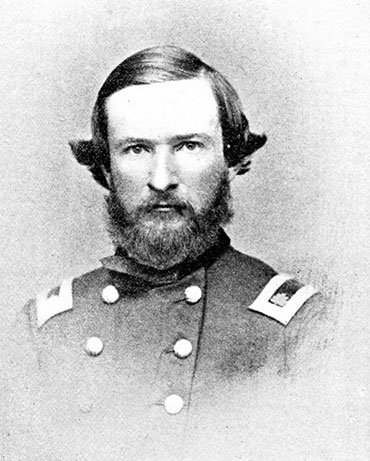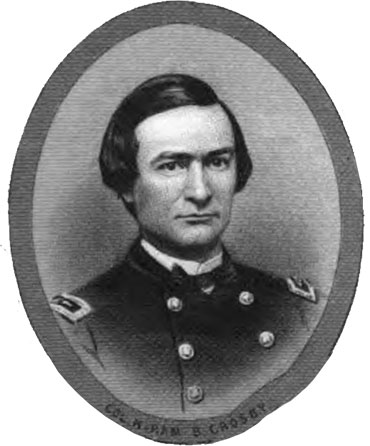Hiram Benjamin Crosby’s Involvement in the American Civil War
Note: This story will be expanded with more detail later.
When the American Civil War began in April 1861, the Norwich community rallied for the war effort. Hiram was active in fund-raising and helping to organize the fit-out of the military companies being formed.[1]
Initially, he did not enlist. Instead, he continued studying and practicing law. It was not until July 1862 that he put a pause on his legal career and enlisted as a private in the 18th Connecticut Regiment for a 3-year term of service.
His administrative skills were quickly recognized and, after serving just three days in Company C, he was transferred to the 21st Connecticut and immediately commissioned as adjutant[2] (an officer who assists the commanding officer in clerical work).
In 1862-3 he served on the staff of the Ninth Army Corps, Gen. O.B. Willcox commanding; and also on the staff of General Sedgwick, who succeeded General Willcox. At the battle of Fredericksburg, December, 1863, he was on the Ninth Army Corps staff, and met on the battlefield classmate Haskell, serving on General Gibbon's staff,—a romantic and touching incident; they had not met since graduation [ten years earlier]. Both were in the battle of Cold Harbor, June 3, 1864, in which Haskell was killed, leading a brigade in a bayonet charge on the enemy's work; they having met June 1.
Crosby won reputation as a military engineer, and was occupied as such, from the fall of 1863, in reconstructing the fortifications at Newburn and Little Washington and other points, and rejoined his regiment in the spring of 1864.[3]
In late June 1864 after the death of his superior officer, Hiram succeeded to the regimental command. This role did not last long because he became “prostrated with intermittent fever”.[4] Disease was the biggest killer for his regiment which lost a total of 175 men during their service—a third of them from being killed or mortally wounded and two-thirds from disease.[5]
Hiram returned to his Norwich home in August on sick leave[6] and was then honorably discharged in September 1864[7]. He had served for just over two years.
Service Record, Twenty-first Regiment Infantry
Adjutant - August 22, 1862
Major - September 3, 1862
Lieutenant-Colonel - June 8, 1864
Colonel - June 27, 1864
Honorably discharged - September 14, 1864[8]
After his discharge and regaining his health, Hiram resumed his law practice in Norwich.
Footnotes & Sources
- [1] Malcolm McGregor Dana, The Norwich memorial: the annals of Norwich, New London County, Connecticut, in the Great Rebellion of 1861-65 (Norwich, Conn., J.H. Jewett and Company, 1873), page 21; digital image, FamilySearch https://www.familysearch.org/library/books/records/item/944493-the-norwich-memorial-the-annals-of-norwich-new-london-county-connecticut-in-the-great-rebellion-of-1861-65
- [2] Henry A. Hazen and S. Lewis B. Speare, eds., A history of the class of 1854 in Dartmouth college, including Col. Haskell's narrative of the battle of Gettysburg (Boston: Alfred Mudge & Son, Printers, No. 24 Franklin Street; 1898), page 20; imaged book, HathiTrust, https://catalog.hathitrust.org/Record/100476707
- [3] Hazen and Speare, eds., A history of the class of 1854 in Dartmouth college, page 20. And: D. Hamilton Hurd, comp., History of New London County, Connecticut with Biographical Sketches of Many of Its Pioneers and Prominent Men (Philadelphia, PA: J.W. Lewis & Company, 1882), imaged book, http://www.archive.org/stream/cu31924028841951
- [4] W.A. Croffut and John M. Morris, The military and civil history of Connecticut during the war of 1861-65: comprising a detailed account of the various regiments and batteries, through march, encampment, bivouac, and battle; also instances of distinguished personal gallantry, and biographical sketches of many heroic soldiers: together with a record of the patriotic action of citizens at home, and of the liberal support furnished by the state in its executive and legislative departments (New York: Ledyard Bill, 75 Fulton Street; 1869, third edition, revised), page 681, image 997/1298, imaged book, HathiTrust, https://babel.hathitrust.org/cgi/pt?id=hvd.32044086282100&seq=31 (accessed 26 Oct 2025)
- [5] Wikipedia, (https://en.wikipedia.org/wiki/21st_Connecticut_Infantry_Regiment), “21st Connecticut Infantry Regiment,” revised 04:48 (UTC), 27 January 2025.
- [6] "War Time News of 50 Years Ago, Aug 4”, Norwich Bulletin (Norwich CT), Saturday 8 August 1914, col. 4; image copy, https://fultonhistory.com/Fulton.html (accessed 16 Sep 2025)
- [7] D. Hamilton Hurd, comp., History of New London County, Connecticut with Biographical Sketches of Many of Its Pioneers and Prominent Men (Philadelphia, PA: J.W. Lewis & Company, 1882); imaged book, http://www.archive.org/stream/cu31924028841951
- [8] Dana, The Norwich memorial, page 21.
- [9] The photo of a bearded Hiram B. Crosby in uniform is from: Members of the Regiment: William Stone Hubbell, Delos D. Brown, Alvin Millen Crane, The story of the Twenty-first Regiment, Connecticut Volunteer Infantry, during the Civil War, 1861-1865 (Middletown, Conn: Press of the Stewart Print. Co., 1900), page 17; imaged book, Internet Archive (https://archive.org/details/00544322.3071.emory.edu/page/17/mode/2up : accessed 18 October 2025).
- [10] The photo of a clean-shaved Hiram B. Crosby in uniform is from: "Dartmouth College Association of New York", The American University Magazine, Nov 1894, page 294, image 330/556; image copy, HathiTrust, https://babel.hathitrust.org/cgi/pt?id=chi.096025527&seq=330
12 November 2025


